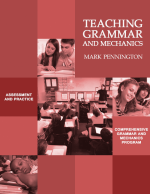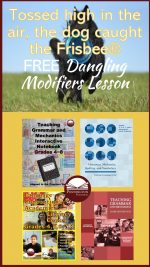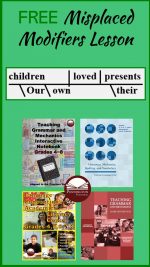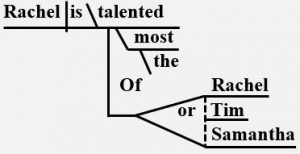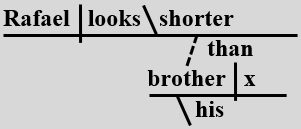Squinting Modifiers
Not too many English teachers will read this article and teach this lesson plan. For the few who do, you need to know that you are really grammar nerding-out by examining the subject of squinting modifiers. I, myself, had never heard of the term until the advent of the Common Core State Standards. I was teaching eighth-grade ELA and found “squinting modifiers” listed as a Language Strand Standard. I knew all about misplaced and dangling modifiers, as no doubt you do, too; however, this old dog needed to learn a few new tricks.
It’s not like I hadn’t seen squinting modifiers in my students’ writing (and in my own). I had assumed that these writing errors were classified as misplaced modifiers. Not so. Neither were squinting and dangling modifiers the same. The latter distinctions are frequently misunderstood. Re-examine the Trump and Clinton graphic after reading the lesson and you’ll see why countless ELA teachers have mistakenly referred to the future POTUS comment as a dangling modifier. It’s quite clearly a squinting modifier, I’m sure you will agree. No huge matter; it’s a modifier error that needs fixin’, but the confusion is not a distinction without a difference. Teaching your students to identify the differences among modifiers will equip your students with specific revision strategies to avoid these errors.
Following is a quick lesson to help your students. If the lesson works for your students, check out these related lessons: comparative modifiers, superlative modifiers, misplaced modifiers, and dangling modifiers (CCSS L.1). These modifier lessons are excerpts from Pennington Publishing’s full-year Teaching Grammar and Mechanics programs.
Squinting Modifiers Lesson
Today we are studying squinting modifiers. Remember that an adjective modifies a noun or pronoun and answers Which one? How many? or What kind? An adverb modifies a verb, an adjective, or an adverb and answers What degree? How? Where? or When? A modifier is a word, phrase, or clause that serves as an adjective or adverb to describe, limit, or add to another word, phrase, or clause.
A squinting modifier is a word or phrase placed between two words so that it could be misunderstood to describe either word. Revise by placing the modifier before or after the word, phrase, or clause that it modifies. Example: Walking up hills quickly strengthens your legs. “Quickly” could modify “hills” or “strengthens.
Sentence Diagram
Modifiers are placed to the right of the predicate after a backward slanted line in sentence diagrams. The object of comparison is placed under the modifier and is connected with a dotted, slanted line. A squinting modifier will create confusion for a sentence diagrammer, because the diagrammer will have some uncertainty as to where to place the modifier. Uncertainly is always a good clue that something is not quite right and must be revised. That’s why sentence diagramming can be an excellent tool for developing writers.
Examine the sentence diagram on the left with the squinting modifier, and revise on the right.
Want to learn more about sentence diagramming and get free lesson plans? Check out “How to Teach Sentence Diagramming.”
Mentor Text
This mentor text, written by Francois de La Rochefoucauld (the French author), avoids squinting modifiers and uses contrasting modifiers to make a humorous point. Let’s read it carefully: ‘Why is it that our memory is good enough to retain the least triviality that happens to us, and yet not good enough to recollect how often we have told it to the same person?
Writing Application
Now let’s apply what we’ve learned to respond to this quote and compose a sentence with contrasting modifiers. Create your own squinting modifier if you wish.
Remember that the above lesson is just an excerpt of the full lesson from my Teaching Grammar and Mechanics programs. Want the full lesson, formatted for display, and the accompanying student worksheet with the full lesson text, practice, fill-in-the-blank simple sentence diagram, practice (including error analysis), and formative assessment sentence dictation? You’ve got it! I want you to see the instructional quality of my full-year programs. Click below and submit your email to opt in to our Pennington Publishing newsletter, and you’ll get the lesson immediately.
*****

Syntax in Reading and Writing
I’m Mark Pennington, author of the full-year interactive grammar notebooks, Syntax in Reading and Writing, and the traditional grade-level 4, 5, 6, 7, 8 and high school Teaching Grammar and Mechanics programs, and the value-packed Grammar, Mechanics, Spelling, and Vocabulary BUNDLES.
Teaching Grammar and Mechanics includes 56 (64 for high school) interactive language conventions lessons, designed for twice-per-week direct instruction in the grade-level grammar, usage, and mechanics standards. The scripted lessons (perfect for the grammatically-challenged teacher) are formatted for classroom display. Standards review, definitions and examples, practice and error analysis, simple sentence diagrams, mentor texts with writing applications, and formative assessments are woven into every 25-minute lesson. The program also includes the Diagnostic Grammar, Usage, and Mechanics Assessments with corresponding worksheets to help students catch up, while they keep up with grade-level, standards-aligned instruction.


